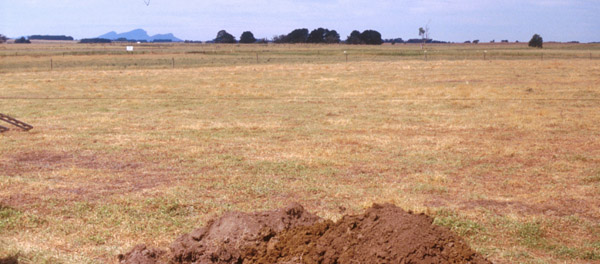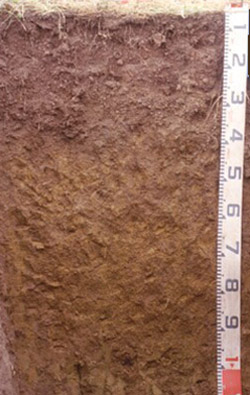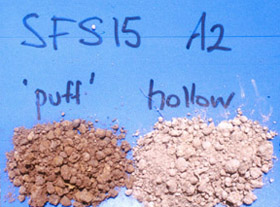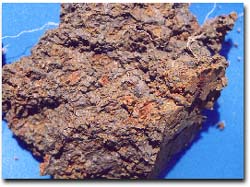SFS15
Location: Hamilton
Australian Soil Classification: Ferric-Sodic, Eutrophic, Brown CHROMOSOL
Northcote Factual Key: DY3.22
Great Soil Group: Possibly brown podzolic.
Soil Mapping Unit: Monivae gravelly loam (slope phase) (Martin and Maher 19).
Land Unit: Monivae Basalt
General Landscape Description: Relatively elevated position in a level to gently undulating basalt plain.
Site Description: Simple slope with moderate gilgai: mounds 2-4 metre intervals with a relative relief of 100 mm or less. Sides and rear of the pit show gilgai depression.
Land Use: Pasture.
Geology: Tertiary/Quaternary basalt.
 SFS15 Landscape |
Soil Profile Morphology:
Surface Soil
| A1 (Ap) | 0-20 cm | Very dark greyish brown (10YR3/2); fine sandy clay loam; weak to moderate fine to medium sub-angular blocky to polyhedral structure; firm consistence dry; pH 5.3; clear change to: |  SFS15 Profile SFS15 Profile |
| A2c | 20-35 cm | Dark brown (10YR3/3) [mound - greyish brown (10YR5/2d), depression - light greyish brown (10YR6/2d)] conspicuously bleached; gravelly loam; very high (>80%) hard magnetic ferro-manganiferous concretions (3-10 mm) mostly magnetic, irregular rounded or sub-rounded (pitted); pH 5.6; clear change to: NOTE: In the depression there is a smooth and wavy boundary up to 50 cm in depth. | |
| Subsoil | |||
| B21t | 35-100 cm | Yellowish brown (10YR5/4) with fine yellowish brown (10YR5/8) and brown (10YR4/3) mottles; light medium clay; fine buckshot (>10%); pH 6.6; clear change to: | |
| B22tss | 100+ cm | Grey (N6) with fine brownish yellow (10YR6/8) mottles; light olive brown (2.5Y5/3) with yellowish brown (10YR5/8) mottles; medium heavy to heavy clay; no buckshot; horizon cracked to base of pit and fissure traceable through B21 above; stress cutans (slickensides); pH 6.6. | |
 Puff and Hollow colours. Puff and Hollow colours. |  Subsoil Mottling. |
Key Profile Features:
- Lateral variation in the soil profile features association with gilgai microrelief.
- Strong texture contrast between the surface (A) horizons and the subsoil (B21) horizon.
- Ferruginous nodules (‘buckshot’) in subsurface (A2) horizon.
Soil Profile Characteristics:
pH | Salinity Rating | |||
Surface (A1 horizon) | Strongly Acid | Low | Non-Sodic | None |
Subsoil (B21 horizon) | Slightly Acid | Low | Non-Sodic | None |
Deeper Subsoil (at 100+cm) | Slightly Acid | Low | Sodic | None |

Horizon | Horizon Depth (cm) | pH (water) | pH (CaCl2) | EC 1:5 | NaCl % | Organic Carbon % | Nitrogen % | Exchangeable Cations | |||
Ca | Mg | K | Na | ||||||||
meq/100g | |||||||||||
A1 | 0-20 | 5.3 | 4.7 | 0.17 | 3.3 | 0.3 | 4.5 | 2.0 | 0.22 | 0.45 | |
A2 | 20-35 | 5.6 | 5.0 | 0.14 | 3.1 | 1.6 | 0.11 | 0.27 | |||
B21 (upper) | 40-60 | 6.6 | 6.0 | 0.20 | 8.1 | 9.4 | 0.25 | 1.4 | |||
B21 (lower) | 60-80 | 6.7 | 6.1 | 0.18 | 6.5 | 9.1 | 0.23 | 1.7 | |||
B22 | 100-110 | 6.6 | 6.0 | 0.27 | 0.03 | 6.5 | 12 | 0.1 | 2.7 | ||
Horizon | Horizon Depth (cm) | Exchangeable Aluminium mg/kg | Exchangeable Acidity meq/100g | Field Capacity pF2.5 | Wilting Point pF4.2 | Coarse Sand (0.2- 2.0 mm) | Fine Sand (0.02- 0.2 mm) | Silt (0.002- 0.02 mm) | Clay (<0.002 mm) |
A1 | 0-20 | 13 | 15 | 34.3 | 12.9 | 7 | 39 | 26 | 20 |
A2 | 20-35 | <10 | 9.6 | 28 | 10 | 20 | 34 | 22 | 21 |
B21 (upper) | 40-60 | 14 | 50 | 33 | 2 | 8 | 7 | 81 | |
B21 (lower) | 60-80 | 14 | 49 | 31 | 3 | 9 | 7 | 78 | |
B22 | 100-110 | <5 | 13 | 3 | 9 | 12 | 73 |
Management Considerations:
Whole Profile
- Plant available water capacity (PAWC) is considered to be medium (estimated at 110 mm) in the upper 100 cm of this soil profile.
Notes
The level to gently undulating basalt plains between Branxholm and Glenthompson consist of an association of Vertic or Ferric Brown Chromosols and Ferric Brown Sodosols. The Chromosols typically occur on the upper slopes and crests of very slight rises that may have scattered surface boulders, and Sodosols on the lower slopes and depressions. Sodosols or Vertosols, occasionally with a sporadic bleached subsurface horizon, are usually found in open depressions or drainage lines.
Profile Described By: Richard MacEwan (December 1999).


